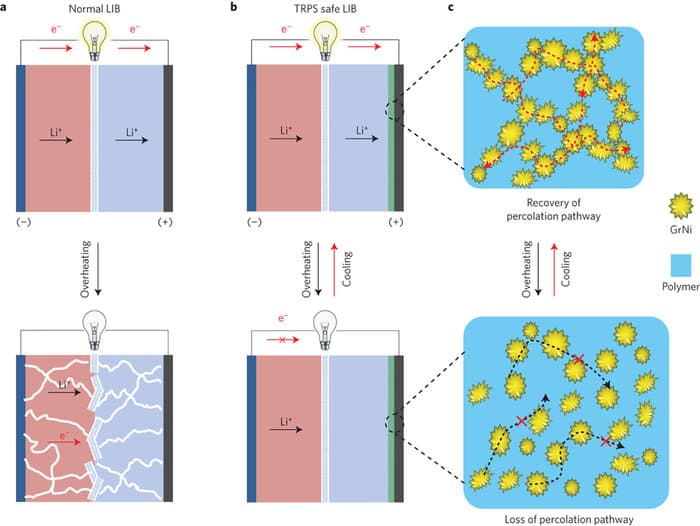New Lithium-Ion Battery Automatically Shuts Down Before Overheating - Stanford Research
A research group comprising, chemical engineers from Stanford University has developed a Lithium-ion battery, that automatically shuts down before overheating, and starts charging once the temperature falls. Most Gizmos use a Lithium-ion battery as the power source, and almost all of them face a problem with overheating. This newly customized battery is expected to get rid of such problems.
Zhenan Bao, team leader of the CE research group at Stanford, stated that people have tried to eliminate accidental fires by using extra tools and chemicals such as a cooling pad, water or by turning off other extra programs running on the device. However, none of them provided a feasible solution. Thus, the need of the hour was to come up with "#-Link-Snipped-#" and innovative, in order to combat the existing overheating menace.
Bao and postdoctoral scholar Zheng Chen, turned to nanotechnology in order to seek a reversible and long lasting solution. The team developed a fast and reversible thermoresponsive polymer switching material that can be incorporated inside batteries, to prevent thermal runaway. The material consists of conductive graphene-coated spiky MIT Research Could Lead To Manufacturing Nano Devices At 1/100th The Cost(nano-spiky) nickel particles as the conductive filler, along with a polymer matrix having a large thermal expansion coefficient. These nano-spikes have high electrical conductivity and high thermal sensitivity.

(a) Normal battery (b) TPRS battery (c) mechanism
The lead author further explained, that in order to conduct electricity, the nano-spikes must be in close vicinity. As the temperature rises, the polythene stretches, causing the spikes to move apart from each other and thereby break the electrical contact. In the lab experiment, when the battery was heated up to 160 F (70 C), the polythene film quickly expanded like a balloon, shutting off the battery. But when the temperature dropped down to 160 F (70 C), the polyethylene shrunk, the particles came in contact, and the battery started regenerating electricity. Researchers also explained the limiting temperature for cutting off the electricity is controllable, and would depend on the number of nano-spiky nickel particles.

(a,b,c,h) nano spikes (d,e,f,i) simulation result (g) Resultant polythene sheet
The research was published in the Nature Energy journal and was co-authored by Nan Liu, Chao Wang, Sean Andrews and Jia Liu; and graduate students Po-Chun Hsu, Jeffrey Lopez, Yuzhang Li and John To. The research was jointly funded by the SLAC National Accelerator Laboratory and the Precourt Institute for Energy at Stanford.
Cui, a research team member claimed that the resultant product was reliable, fast and provided a reversible strategy that can achieve both high battery performance and improved safety. With several desirable features that have eliminated existing problems, we can hope that the automated Li ion battery would soon be launched in the market.
Bao's interview on this research -
Source: #-Link-Snipped-# | #-Link-Snipped-#
Zhenan Bao, team leader of the CE research group at Stanford, stated that people have tried to eliminate accidental fires by using extra tools and chemicals such as a cooling pad, water or by turning off other extra programs running on the device. However, none of them provided a feasible solution. Thus, the need of the hour was to come up with "#-Link-Snipped-#" and innovative, in order to combat the existing overheating menace.
Bao and postdoctoral scholar Zheng Chen, turned to nanotechnology in order to seek a reversible and long lasting solution. The team developed a fast and reversible thermoresponsive polymer switching material that can be incorporated inside batteries, to prevent thermal runaway. The material consists of conductive graphene-coated spiky MIT Research Could Lead To Manufacturing Nano Devices At 1/100th The Cost(nano-spiky) nickel particles as the conductive filler, along with a polymer matrix having a large thermal expansion coefficient. These nano-spikes have high electrical conductivity and high thermal sensitivity.

(a) Normal battery (b) TPRS battery (c) mechanism

(a,b,c,h) nano spikes (d,e,f,i) simulation result (g) Resultant polythene sheet
The research was published in the Nature Energy journal and was co-authored by Nan Liu, Chao Wang, Sean Andrews and Jia Liu; and graduate students Po-Chun Hsu, Jeffrey Lopez, Yuzhang Li and John To. The research was jointly funded by the SLAC National Accelerator Laboratory and the Precourt Institute for Energy at Stanford.
Cui, a research team member claimed that the resultant product was reliable, fast and provided a reversible strategy that can achieve both high battery performance and improved safety. With several desirable features that have eliminated existing problems, we can hope that the automated Li ion battery would soon be launched in the market.
Bao's interview on this research -
Source: #-Link-Snipped-# | #-Link-Snipped-#
Replies
You are reading an archived discussion.
Related Posts
The husband-wife duo Nisha and Mithun Chandra started Duffl (previously Tete-a-Rent) As India's first, curated peer to peer fashion re-sale platform in October 2014. Over the past year, Duffl has...
Hi guys!!!!! Thats is my Special project tittle for bachelor,actually i need your ideas especially in methodology part
Massachusetts Institute of Technology and Purdue University have jointly developed an efficient new form of the incandescent light bulb. The research was published in Nature Nanotechnology by three MIT professors...
i ve designed a rf transmitter and recievr pair circuits.. but i ve a prob in that... how can we transmitt a data to a particuler reciever.... like the transmitter...
Quote:
The FFZERO1 concept vehicle is an electric supercar based on a modular vehicle architecture that the firm claims will enable it to rapidly introduce a diverse range of vehicles....
